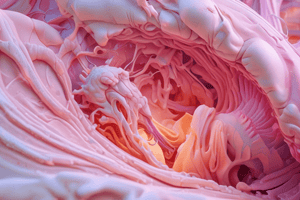Podcast
Questions and Answers
What is the main component of cartilage tissue?
What is the main component of cartilage tissue?
- Chondrocytes
- Perichondrium
- Extracellular matrix (correct)
- Glycoproteins
Which type of cartilage is the most common form?
Which type of cartilage is the most common form?
- Dense cartilage
- Elastic cartilage
- Fibrocartilage
- Hyaline cartilage (correct)
What is the function of chondrocytes in cartilage?
What is the function of chondrocytes in cartilage?
- Breaking down matrix molecules
- Synthesizing and secreting matrix molecules (correct)
- Supporting soft tissues
- Guiding bone growth and development
What is unique about the structure of cartilage?
What is unique about the structure of cartilage?
Which of the following is a function of cartilage?
Which of the following is a function of cartilage?
What is the main component of the territorial matrix?
What is the main component of the territorial matrix?
Which type of cartilage is found in the temporary skeleton of an embryo?
Which type of cartilage is found in the temporary skeleton of an embryo?
What is the function of perichondrium in cartilage?
What is the function of perichondrium in cartilage?
What is the primary function of elastic cartilage?
What is the primary function of elastic cartilage?
Which type of cartilage has a distinct perichondrium?
Which type of cartilage has a distinct perichondrium?
What is the primary component of the matrix in elastic cartilage?
What is the primary component of the matrix in elastic cartilage?
What is the location of fibrocartilage?
What is the location of fibrocartilage?
What is the process of chondroblasts multiplying in the embryonic stage?
What is the process of chondroblasts multiplying in the embryonic stage?
What is the type of growth where progenitor cells in the perichondrium differentiate into chondroblasts?
What is the type of growth where progenitor cells in the perichondrium differentiate into chondroblasts?
How many types of chondrogenesis are there?
How many types of chondrogenesis are there?
What is the characteristic of cells in the isogenous group?
What is the characteristic of cells in the isogenous group?
Flashcards are hidden until you start studying
Study Notes
Cartilage Structure
- Composed of Cartilage tissue and Perichondrium
- Cartilage tissue is a specialized form of Connective Tissue
- Cell: Chondrocytes (synthesize and secret Extracellular Matrix)
- Extracellular matrix consists of:
- Glycosaminoglycans (GAGs)
- Proteoglycans
- Collagen
- Hyaluronic acid
- Glycoproteins
- Avascular and lacks lymphatic vessels and nerves
Perichondrium
- Out layer: collagen type I and fibroblasts
- Inner layer: more cells, mesenchymal stem cells
Classification of Cartilage
- Classified into three types based on the type of fibers embedded in the matrix:
- Hyaline cartilage
- Elastic cartilage
- Fibrocartilage
Hyaline Cartilage
- The most common form of cartilage
- Locations:
- In the embryo: temporary skeleton
- In adult: Respiratory tract, Ventral part of ribs, Articulating surfaces of long Bones and joints
- Functions:
- Provides smooth, low-friction surfaces in joints
- Structural support for respiratory tract
Elastic Cartilage
- Great flexibility and elasticity
- Location:
- The auricle of the ear
- The walls of the external auditory canals
- The auditory (Eustachian) tubes
- The epiglottis
- Function:
- Provides flexible shape and support of soft tissues
- Structure:
- Matrix: abundant of elastic fibers and collagen type II
- Cells and perichondrium are similar to hyaline cartilage
Fibrocartilage
- Location:
- Intervertebral disks
- Pubic symphysis
- Meniscus of knee joint
- Structure:
- Chondrocytes: singly and often in aligned isogenous aggregates
- Matrix: type II collagen, fibroblasts and dense bundles of type I collagen
- No distinct Perichondrium
- Function:
- Provides cushioning, tensile strength, and resistance to tearing and compression
Chondrogenesis
- Embryonic stage: Mesenchymal cells → Chondroblasts → Production of the ECM → Isogenous cells
- Two types of chondrogenesis:
- Appositional growth
- Interstitial growth
Appositional Growth of Cartilage
- Progenitor cells in the perichondrium differentiate into chondroblasts
- Most important during postnatal development
Interstitial Growth of Cartilage
- Cartilaginous structures grow by mitosis of existing chondroblasts in lacunae
- Isogenous cells
- Synthesis of matrix contributes greatly to the growth of the cartilage
Studying That Suits You
Use AI to generate personalized quizzes and flashcards to suit your learning preferences.




